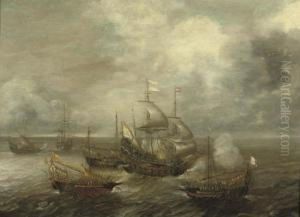Savery Pieter Paintings
Pieter Savery, born in 1576 in Kortrijk, which was then part of the Spanish Netherlands, is a notable figure in the history of Flemish and Dutch art. His work primarily spans the late Renaissance and early Baroque periods, showcasing his versatility across various genres, including landscape, still life, and animal paintings. Pieter was part of the Savery family, a lineage that included several artists, most famously his younger brother Roelandt Savery, who also gained prominence as a painter.
Pieter's early life was marked by the turbulent socio-political climate of the Spanish Netherlands, which likely influenced his relocation to the Northern Netherlands. Details about his training are sparse, but it is believed that he was influenced by the works of Gillis van Coninxloo, a pioneer of the dense, forested landscape genre, which Pieter would later adopt and adapt in his own compositions. His move to Amsterdam and later to Utrecht played a significant role in his development and exposure to different artistic circles.
Throughout his career, Pieter Savery's work was characterized by meticulous attention to detail, a vivid depiction of nature, and the ability to imbue his landscapes with a sense of depth and realism. His landscapes often featured a combination of wooded scenes, wild animals, and occasionally, biblical or mythological figures, showcasing his skill in integrating human and natural elements. His still lifes, which were less common, demonstrated an early example of the genre that would later become a significant aspect of Dutch Golden Age painting.
Despite his contributions to the art world, Pieter Savery's legacy was somewhat overshadowed by that of his brother Roelandt, whose work was more widely recognized and celebrated. However, recent scholarship has begun to reassess Pieter's impact, particularly in the context of the development of landscape and animal painting in the early 17th century. His paintings are now appreciated for their technical skill, innovative compositions, and the role they played in the evolution of Northern European art.
Pieter Savery's death in 1639 marked the end of a career that had navigated the shift from the Renaissance ideals of harmony and proportion to the Baroque's dynamism and expressiveness. His works remain in several European collections, serving as a testament to his artistic achievements and the transitional period of art history he represents.
